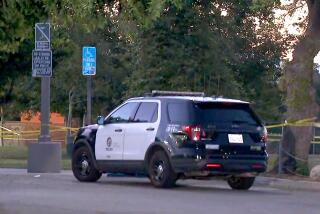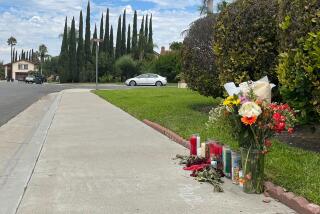Homeless Slaying Causes Fear
- Share via
The recent beating death of a homeless Oakland man by a group of youths has surprised and angered many people in this community, prompting outreach workers to warn transients in encampments here of possible danger.
Even in a city known for its high homicide rate -- the homeless death brought the number to 44 this year -- the callousness of the crime caught community leaders and some police off guard.
“It’s unbelievably vicious,” said Oakland Police Chief Richard Word. “It’s hard to explain.”
The killing is the latest in a string of attacks against the homeless by youths, police say.
On Friday police arrested three teens on suspicion of murder in connection with the death, Patrol Sgt. Dave Downing said.
“I think they just did it because it was fun,” Downing said.
He said police found evidence of the crime at the boys’ homes. Police say the homeless man was beaten with boards and shot with a BB gun.
Word said he knows of four other assaults on homeless people in the last several weeks.
Police say they’ve located and questioned witnesses to several of the assaults and the homicide.
The case drawing most of the attention involves Dalrus Joseph Brown, also known as DJ, a man who spent his days repairing bicycles.
The slight, 55-year-old Brown was beaten to death about 5 a.m. July 17 by a group of boys between the ages of 16 and 20, said homicide Sgt. Bruce Brock.
“It appears he was sleeping in his little makeshift housing and he was confronted by some of the juveniles who just started beating on him,” Brock said. “I think they used some sticks ....”
The killing occurred in a predominantly low-income west Oakland neighborhood that has been gentrifying in recent years as young professionals move into single-family homes. Nearby is barracks-style public housing that has been remodeled, a recycling plant and a city park.
Brown had lived in an encampment with other transients for the last two years behind a cereal manufacturing plant.
He created his home out of two shopping carts with a tarp across the top and slept on a mattress underneath, according to those who saw him. The makeshift shelter rested against the fence of the Wade Johnson Park along the railroad tracks.
“He was a nice person to me. When I talked to him, he was polite,” said Sterling Savely, chairman of California Cereal Products Inc., which operates the 120,000-square-foot plant near the encampment.
He said Brown, who “always appeared to be lucid,” spent his days repairing bicycles from spare parts or visiting in the park with other homeless men.
Savely said Brown was cooperative in cleaning up the area whenever visitors were coming to the plant. He and the handful of other homeless residents would temporarily move their belongings to the park.
“It’s going to be hard going out there and not remembering him,” Savely said. “For two years he was there. If there was any issue or problem, he was the guy who could accommodate you.”
Following Brown’s death, advocates are trying to get the word out about the dangers facing homeless people.
“All the providers have come together and are trying to warn people of the dangers of living on the street,” said Alex McElree, founder and executive director of Operation Dignity, which runs an outreach, shelter and transitional housing program for Oakland’s homeless. “We’re always out there talking about the dangers. Now we’re focused on getting to all the encampments quickly.”
He said his workers are telling transients to remain aware of their surroundings and pair up for safety. McElree believes the homeless are heeding the warnings. “They’re hunkered down,” he said. “They’re laying low.”
He estimated that there are 1,500 to 2,000 homeless people on the streets of Oakland at any one time, although many more don’t live on the streets but stay temporarily with friends or family.
Boona Cheema, executive director of Building Opportunities for Self-Sufficiency, a Berkeley-based housing, job training and health services program, said transients are vulnerable to assaults and other crimes.
“When people are living in encampments, isolated in the bushes, they’re such easy targets,” Cheema said.
City officials say the attacks on the homeless are unusual.
“Most of the violence in our community is related to narcotics,” said Deputy Police Chief Michael Holland. “This is an aberration.”
Oakland City Councilwoman Nancy Nadel, whose district includes the neighborhood where Brown was killed, called the attacks and the killing horrifying.
“It’s hard to understand what’s in the minds of people who do that,” she said.
More to Read
Sign up for Essential California
The most important California stories and recommendations in your inbox every morning.
You may occasionally receive promotional content from the Los Angeles Times.













